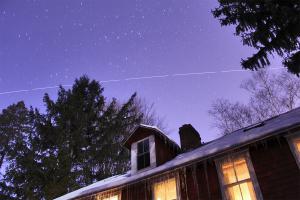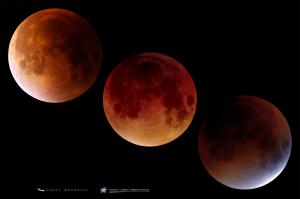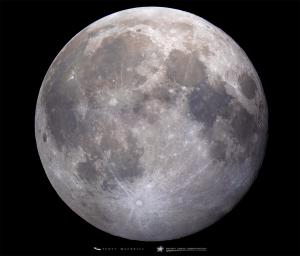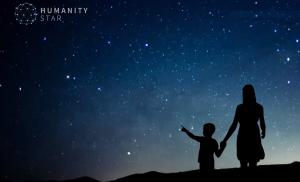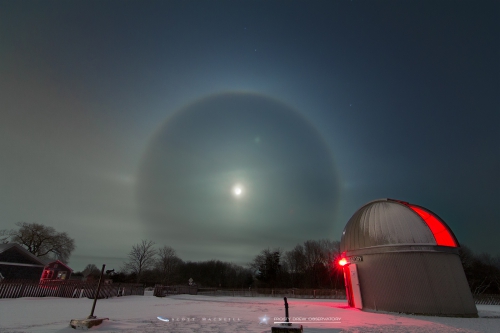
Stargazing Nights
- Where:
- Frosty Drew Observatory
- When:
- Friday January 26, 2018 at 6:00 p.m
- Cost:
- $1 Suggested Donation per Person
Tonight is Stargazing Night at Frosty Drew Observatory and for the second week consecutively, we have clear skies lined up for our night of amazement! We can expect clear skies for nearly the entire night with a slight chance of increasing haze as temps rise overnight. We also have the 73% waxing gibbous Moon for our entire session, and though brightening up the sky a lot, it’s a great phase to catch sight many remarkable craters and features along the lunar surface. Temps will warm up as the night progresses, though it’s winter time, and we are talking about temps in the 20’s, so dress for it!
We open at 6:00 p.m. tonight. In the Observatory, telescopes will start off with views of the Moon, showcasing Copernicus Crater, Plato Crater, Montes Carpatus, and more. Tonight’s list also includes the Orion Nebula, double star – Herschel 3945, M46 open star cluster, and anything else the cosmos has to offer. In the Sky Theatre, temps will be a bit more manageable and on screen will be our feature of celestial objects photographed at Frosty Drew Observatory. We will stay open until 11:30 p.m. or until visitors stop coming out.
Overall, tonight is a good night to be out, especially if the Moon is your dig. Dark sky freak-outs will not happen tonight with the bright gibbous Moon, though the Moon will look awesome in our telescope. It’s a clear Friday night, which is not something we can take for granted at this point. So stop in and get your geek on with the Moon, and celebrate clear skies with us tonight at Frosty Drew Observatory!
------------------
Weekly Happenings
Scott MacNeill
Step outside tonight at 5:29 p.m. to catch the International Space Station (ISS) passing by. Face the south horizon to spot the ISS rising to 24° heading towards the ENE. If you miss out, second chances rock, and at 7:05 p.m. you can catch the ISS again over the west horizon rising to 31° before orbital sunset occurs, which is when the ISS passes into Earth’s shadow. These times work for Southern New England and will reasonably apply to the Northeast. Grab times for additional passes this week on the Observatory page. For times over your location, visit NASAs Spot the Station.
On Wednesday, January 31, 2018, the (super ?) blue penumbral eclipse Moon will occur for all of us in New England. Though if you are on the western side of the USA, you can add “total eclipse” to the list of adjectives describing Wednesday’s Moon. The full lunar phase will occurs at 8:28 a.m. EST on Wednesday the 31st. Being that this is the second Full Moon of January, we can consider it a Blue Moon, though do not expect the Moon to appear more blue in color than any other Full Moon. In New England we will pretty much miss the total lunar eclipse that will accompany the Full Moon, as it will begin right at moon set. Though, the penumbral eclipse stage will be visible, which is when the Moon enters Earth’s secondary shadow, called the penumbra. Observers in the Midwest and western states, can catch a view of some of the eclipse, with the Pacific Northwest, Alaska, and Hawaii setup for the full event. Penumbral eclipse begins at 5:51 a.m. EST with partial eclipse beginning at 6:48 a.m. EST. If you’re in New England and have a clear view of the western horizon, set your alarm, you may catch the start of partial eclipse. Check out NASA’s map of eclipse visibility and see if you are setup for a fabulous lunar event.
Wednesday’s Full Moon is also being called a super moon, which happens when the Full Moon coincides with the lunar perigee (the Moon’s closest point to Earth in it’s 27.3 day orbit). But the lunar perigee occurs on Tuesday, January 30th at 4:55 a.m. at a distance of 223,069 miles. That’s about 27.5 hours before the full phase, during which the Moon will distance itself by an additional 2,497 miles. Using the arbitrary definition of the astrologer who came up with the “super moon” term to describe a perigee-syzygy, Richard Nolle; this Full Moon occurs within 90% of the Moon’s closest approach (91.39%). But a perigee-syzygy occurs when the Earth, Moon, and Sun align (Full Moon) during the lunar perigee, not a day before or after. Being that the term “super moon” is loosely defined, and we love to call the Moon super (let’s face it, it is!), perhaps this is a good opportunity to call this event a super moon. Maybe in a few decades the Full Moon will just be the Super Moon? Regardless, get out and see the super awesome crazy-bright show-stealing blue bloody sexy-beast total eclipse full Moon and find a name that fits for you.
This past Sunday, January 21, 2018. A budding private cubesat launch services company launched into orbit a small 3” diameter, highly reflective satellite from it’s New Zealand launch site. The satellite, called “Humanity Star” is yet another attempt at launching a satellite into orbit with the sole purpose of being visible to those looking up on Earth. Last year a Russian organization launched a satellite called “Mayak” that had a similar purpose, but failed to deploy. We are yet to see any reports or photos of Humanity Star visibility, though we began tracking it early this morning (applicable pass times will appear on the Observatory page), alongside other satellite tracking apps. Putting the loud opinions aside, I would have to see the satellite pass, before freaking out about how bright it may be. Regardless, if the deployment is successful, this may inspire more people to look to the sky. I can dig that.
-Scott

